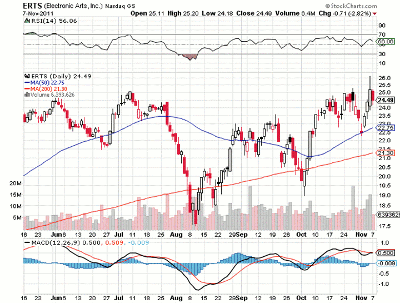With an expansive list of technical buy signals in place for Electronic Arts (ERTS), traders have a low-risk, low-stress way to play the rally using clearly defined stop placement.
Shares of Electronic Arts (ERTS) had a nice run higher during October, and despite a modest pullback, the stock appears to have broken out decisively to the upside once again. Here’s a closer look at the exceedingly bullish daily chart of this Nasdaq issue:
When you get so many bullish technicals on one chart, it might be a good idea to pay special attention to any and all new trade-entry triggers. Currently, a new Rahul Mohindar oscillator (RMO) swing buy signal (on the MetaStock platform) has just fired here on the ERTS daily chart.
Lots of times, when evaluating the technical situation on a given chart, you might expect to see three or four meaningful technical and/or fundamental dynamics that all agree that the line of least resistance is toward higher prices.
However, in the case of this daily chart of ERTS, we find at least six significant bullish technical factors at work:
- A solid uptrend in force
- Superior 13-week comparative relative strength versus .SPX
- Very strong long-term money flow based on the 100-period Chaikin money flow histogram (CMF)(100)
- A new 52-week high
- A new RMO swing buy signal
- A wide-range breakout bar
Overall, this looks like a very attractive, fairly low-risk long entry setup in ERTS, one that might be best traded with a risk tolerance of no more than 1% to 2% of total account equity.
Since most RMO traders enter on a buy stop just above the trigger bar high (vice versa for short RMO trade set-ups), this would equal a hypothetical entry price of about $26.14.
Running a two-bar trailing stop of the daily lows as both the initial and trade management stop would mean a stop loss of about $22.74 or a per-share risk of $3.60.
See related: How to Place an Objective Stop Loss
The $25 level seems to be an area of resistance, so a solid close above that level with good volume would be icing on the cake.
If you have a $25,000 cash equities account and want to limit risk to 1% ($250), then you simply take $250 and divide it by $3.60 to determine the number of shares to trade.
The amount works out to 69.4444 shares, but for the sake of a better fill, just round it up to 70 and you’re still going to be in the ballpark. Once the trade is on and your initial stop is set, just keep adjusting that two-bar trail until the trade finally stops out for a win or a loss.
It’s a simple and stress-free way to manage a swing-style trade that works well in the real world. Try it out on your next swing trade, no matter what kind of entry trigger you rely on.
By Don Pendergast of Linear Trading Systems LLC






















